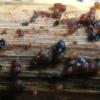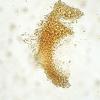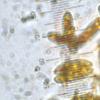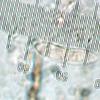
17-12-2025 18:35
 Michel Hairaud
Michel Hairaud
Bonjour à tous/Hi to everyone I am passing along

15-12-2025 15:48
 Danny Newman
Danny Newman
Melanospora cf. lagenaria on old, rotting, fallen

15-12-2025 15:54
 Johan Boonefaes
Johan Boonefaes
Unknown anamorph found on the ground in coastal sa

15-12-2025 21:11
 Hardware Tony
Hardware Tony
Small clavate hairs, negative croziers and IKI bb

15-12-2025 07:09
 Danny Newman
Danny Newman
indet. Rutstroemiaceae sp. on unk. fallen leavesMc

15-12-2025 07:05
 Danny Newman
Danny Newman
Pseudosclerococcum golindoi (det: Zotto)near Cosb

15-12-2025 11:49
 Danny Newman
Danny Newman
ITS sequences from the following two collections B

15-12-2025 12:34
 Danny Newman
Danny Newman
indet. Rhytismataceae on oak leafnear Purchase Roa
Hydropisphaera?
Marja Pennanen,
24-08-2010 08:13
I picked some Typhula crassipes and studied the Epilobium stem home. Supprisingly (or maybe not...) I saw something more there.
They are about 0,2 to 0, 3 mm wide:
Marja Pennanen,
24-08-2010 08:21
Re:Not an anamoph
I thoght, that they are surely some anamorphs, but put still one between classes to see, that it was worth studying. The views were strange to me and I couldn't find anything like this from my sources.
The spores are about 17-20x4-5 and can have a septa.
Asci are (as far as I can see them) 60-85x10-12 almoust invisible and with no IKI reaction.
So I'm in trouble as nearly always, when I meet something new: Marja
The spores are about 17-20x4-5 and can have a septa.
Asci are (as far as I can see them) 60-85x10-12 almoust invisible and with no IKI reaction.
So I'm in trouble as nearly always, when I meet something new: Marja
Alain GARDIENNET,
24-08-2010 17:23
Re:Not an anamoph
Hi Marja,
It belongs perhaps to the genus Hydropisphaera (Bionectriaceae).
This recolt would interest someones, like Christian.
He comes back in two weeks.
I suggest you to recall the subject of this message : "Hydropisphaera ?"
Alain
It belongs perhaps to the genus Hydropisphaera (Bionectriaceae).
This recolt would interest someones, like Christian.
He comes back in two weeks.
I suggest you to recall the subject of this message : "Hydropisphaera ?"
Alain
Marja Pennanen,
24-08-2010 22:18
Re:Hydropisphaera?
Hello Alain,
and thank you. So this is something new, which I should study more. No knowledge, what Bionectriaceae are... But maybe sometimes later, I was once again overcollecting today ;)
You suggestion has been completed, too ;)
Greetings: Marja
and thank you. So this is something new, which I should study more. No knowledge, what Bionectriaceae are... But maybe sometimes later, I was once again overcollecting today ;)
You suggestion has been completed, too ;)
Greetings: Marja
Christian Lechat,
25-08-2010 01:20

Re:Hydropisphaera?
Hi, Marja
I agree with Alain, your fungus resembles to Hydropisphaera, could you please to make a vertical section? I would like to see if cells are thin walled or not.
All the best,
Christian
I agree with Alain, your fungus resembles to Hydropisphaera, could you please to make a vertical section? I would like to see if cells are thin walled or not.
All the best,
Christian
Marja Pennanen,
25-08-2010 08:17
Re:Hydropisphaera?
Hi Christian,
thank you, but sorry, I can not make any sections-never done and the specimen has dried.
I'm really a beginner and my equipment and experience are very limited.
In fact I can't even imagine how a section of such a tiny fungus is done...
Anyway, here's a photo, where I imagine are some cells besides the spores:
Best wishes: Marja
thank you, but sorry, I can not make any sections-never done and the specimen has dried.
I'm really a beginner and my equipment and experience are very limited.
In fact I can't even imagine how a section of such a tiny fungus is done...
Anyway, here's a photo, where I imagine are some cells besides the spores:
Best wishes: Marja
Marja Pennanen,
26-08-2010 10:17
Marja Pennanen,
26-08-2010 10:22
Alain GARDIENNET,
26-08-2010 11:04
Re:Hydropisphaera?
There are a few possibilities, H. arenula is a credible one (but spores are given in 14-16 x 3.5-4 µm).
You should make micro for both recolts because it isn't perhaps the same.
Describe the spores : are they smooth or not. With color (blue coton for example), you could see if they are striate, verrucose or else.
To make a vertical section, take a new razor blade, and cut in the median plan. Here is a section of a recent collection of Nectria lamyi. See Christian's ones, he is an expert in the matter !
Good luck !
Alain
You should make micro for both recolts because it isn't perhaps the same.
Describe the spores : are they smooth or not. With color (blue coton for example), you could see if they are striate, verrucose or else.
To make a vertical section, take a new razor blade, and cut in the median plan. Here is a section of a recent collection of Nectria lamyi. See Christian's ones, he is an expert in the matter !
Good luck !
Alain
NC NC,
26-08-2010 12:05
Marja Pennanen,
26-08-2010 12:09
Marja Pennanen,
26-08-2010 12:12
Alain GARDIENNET,
26-08-2010 13:02
Re:Hydropisphaera?
KOH- is correct.
Could you observe spores in blue ?
alain
Could you observe spores in blue ?
alain
Marja Pennanen,
30-08-2010 11:08












